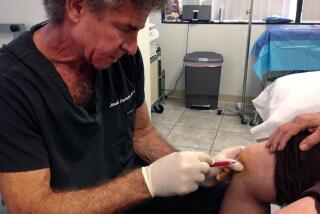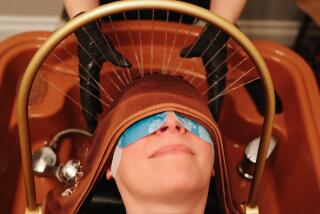Hundreds of companies in the U.S. are selling unproven stem cell treatments, study says
- Share via
Have your weekly pickup basketball games left you with pain in your knees that just won’t go away? Do you suffer from chest pain, lung disease or kidney failure? Has an accident left you with partial paralysis? Or, would you like to have a more rewarding sex life?
If any of these conditions — or dozens of others — afflict you, there’s a clinic in the United States that would be happy to heal you with stem cells.
From coast to coast, at least 351 businesses at 570 locations are marketing stem cell therapies that have not been fully vetted by medical researchers or blessed by the U.S. Food and Drug Administration, according to a study published Thursday in the journal Cell Stem Cell.
Paul Knoepfler, a bona fide stem cell researcher at UC Davis with a doctorate in molecular pathology, and Leigh Turner, a bioethicist at the University of Minnesota who studies the ramifications of medical tourism, scoured the Internet to find companies advertising all sorts of stem cell treatments directly to patients and their families. They used nearly 100 search terms to identify as many websites as they possibly could — and turned up a lot more than they thought they would.
“We felt confident the final tally would be in the triple digit,” Turner said. “Still, I did not expect to find 351 distinct businesses or 570 clinics.”
Nearly every state had a stem cell clinic, Turner and Knoepfler found. The state with the most clinics — 113 — was California, followed by Florida (104), Texas (71) Colorado (37), Arizona (36) and New York (21). Beverly Hills (population 34,290) had 18 clinics, more than any other American city, and Los Angeles had 12. With 10 and 11 clinics, respectively, Phoenix and Scottsdale, Ariz., represented another cluster. New York City had 14 clinics, and San Antonio had 13.
The researchers don’t know why clusters of clinics appeared where they did, but they plan to investigate this in future studies. Perhaps there are simply more clinics in metropolitan areas with more people, and hence more potential customers. Perhaps they’re more likely to proliferate in places where alternative approaches to medicine are more readily embraced, or where the population is older and more receptive to procedures that purport to have regenerative effects. It’s also possible that the regulatory environment plays a role.
About 80% of the clinics advertised services that used stem cells derived from the patient’s own tissues — usually fat, but also bone marrow or circulating blood. Some therapies involved combinations of these cells, according to the study.
In the other 20% of cases, clinics promoted treatments involving stem cells from other sources, such as amniotic fluid, placental tissue or umbilical cords. “The precise source of these products is not clear in all cases,” the researchers noted.
Turner and Knoepfler found a handful of clinics that advertised treatments using “embryonic stem cells” or “induced pluripotent stem cells,” which are supposed to be adult cells rewound to an embryonic-like state. It wasn’t clear whether the cells would be custom-created for each patient, nor was it clear if they were to be derived from the patient’s own cells or came from a donor’s.
At the far end of the spectrum were two clinics that claimed to use “bovine amniotic cells” — in other words, stem cells from the amniotic fluid of cows.
If the clinics are to be believed, there’s no medical problem that stem cells can’t fix. More than any other type of condition, the websites claimed to treat orthopedic and sports medicine problems, such as wear and tear on muscles and joints. “Pain” was another common indication for stem cell treatments.
Some clinics said they used stem cells to enhance cosmetic procedures such as breast augmentation and wellness boosters that purport to improve sexual function.
The cells were also touted for more serious problems, including heart disease, immune system disorders, spinal cord injuries, lung disease and neurological conditions such as Parkinson’s disease, amyotrophic lateral sclerosis (aka Lou Gehrig’s disease) and Alzheimer’s, among others. In many of these cases, “there is no established scientific consensus that proven safe and efficacious stem cell treatments now exist,” the researchers wrote.
Of particular concern to Turner and Knoepfler were clinics that targeted parents of children with autism, cerebral palsy and muscular dystrophy. “This kind of advertising reveals another tangled knot of ethical and legal concerns,” they wrote, since the recipients of these dubious treatments aren’t the ones making the decisions.
Some clinic websites acknowledged that their treatments were not FDA-approved; others instead emphasized the view that their therapies did not require FDA approval, Turner said.
The researchers were careful not to say that any particular clinic was violating federal or state laws or regulations. However, since many of the clinics advertised treatments “that do not appear to fit FDA criteria … there are clear grounds for concern that some of the companies we found are not compliant with federal regulations,” they wrote.
Patients who are already beset with real medical problems could find themselves in even worse shape — physically, emotionally or financially — if they receive such treatments, the pair added. And if those treatments don’t go well, it could tarnish the reputation of the entire stem cell research field, Knoepfler said in a statement.
Last fall, the FDA issued a draft document outlining its views about how human cells, including stem cells, ought to be regulated. A few months later, the agency warned the Irvine Stem Cell Treatment Center that it wasn’t operating by the book.
It will take a lot more to make sure that patients get the protection they need, Turner said.
“There is an obvious need for the FDA, FTC (Federal Trade Commission), state medical boards and other regulatory bodies to play a more effective role in regulating the marketplace for stem cell interventions,” he said. Without it, these clinics are able “to peddle false hope for sizable profits.”
Follow me on Twitter @LATkarenkaplan and “like” Los Angeles Times Science & Health on Facebook.
MORE IN SCIENCE
Heart disease and cancer are responsible for nearly half of all deaths in the U.S., report says







